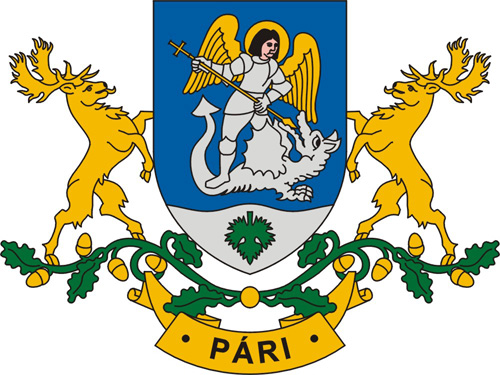
(Tolna megye)
Heraldikai leírás:
Álló, háromszögű pajzs kék mezejében hullámvonallal határolt ezüst pajzsláb, ebben lebegő helyzetű, lefelé fordított zöld szőlőlevél. A kék mezőben lebegő helyzetű címerkép: Szent Mihály arkangyal félbalra fordult alakja természetes színében, fekete hajjal, ezüst páncélban, arany szárnyakkal. Fejét arany dicsfény övezi. Jobb lábával az előtte fekvő, balra fordult, fejét hátravető ezüst sárkányra tipor, miközben két kezében tartott, keresztvégződésű arany lándzsáját a sárkány torkába döfi. A címerpajzsot kétoldalról egy-egy befelé fordult, ágaskodó arany dámszarvas tartja, melyek arany makktermésekkel ékített, zöld tölgyfaágból képzett arabeszken állnak. Az arabeszkről függő, hármas tagolású arany szalagon feketével nagybetűs PÁRI felirat. A településnév előtt és után egy-egy díszpont.
A címer magyarázata:
A címerkép megfogalmazásához a település jellemzői adtak támpontot. A jelképek a település természeti adottságaihoz és vallásához kötődnek. A címer fő alakja a templom titulusa, egyben Pári védőszentje, Szent Mihály arkangyal, amint a gonoszt jelképező sárkány elleni győztesként a legyőzöttre tipor.
A címerben szereplő tölgy a környező erdősségek őshonos fája. Utal ugyanakkor az ősökre is, akik erdőműveléssel foglalkoztak. A tölgy romolhatatlannak vélt fája révén vált a rendíthetetlen jellem, az erő, a férfiasság, a győzelem jelképévé.
Az erdő itteni jellegzetes, országos hírű vadállományát jelképezik a címer pajzstartói, a dámszarvasok.
A település patakját a hullámvonallal határolt pajzsláb szimbolizálja. A víz a négy fő elem egyike, a megújhodást, a megtisztulást jelképezi a keresztségben.
A szőlőlevél, a szőlőfürt a hagyományos szőlőművelésre utal.
(The County of Tolna)
Heraldic description:
Triangular shield erect and azure. In base argent, bordered by a wavy line a vine leaf vert is borne encouped and turned upside down. In field azure the figure of archangel St. Michael is borne encouped and at a slant. The archangel’s figure is tinctured proper; haired sable, armored argent, winged or. The saint’s head is surrounded by a halo or. With his right foot the saint is treading on a dragon argent, lying on the ground in front of him and slightly turning toward the sinister. The dragon’s head is put back. With both hands the saint is holding a cross-pointed lance or and he is stabbing it into the dragon’s throat. Supporters from the dexter and from the sinister side are two deer or and rampant; they are standing on an arabesque of oak branches, vert and acorned or. From the arabesque a tripartite ribbon or is hanging in which the settlement’s name PÁRI is inscribed in capital letters sable. Before and after the settlement’s name an ornamental dot.
The interpretation of the settlement’s coat of arms:
The characteristics of Pári serve as support for the interpretation of the settlement’s coat of arms. The charges are related to the natural surroundings on the one hand, and to the inhabitants’ religious faith on the other. The central charge in Pári’s coat of arms is St. Michael, the patron saint of the village. In the village’s coat of arms the saint is featured as defeating the dragon, the symbol of evil and he is treading on the beast’s body.
The oak tree is a native tree in the neighbourhood of the settlement. At the same time it is also a reference to the predecessors of today’s inhabitants, who were woodcutters and forestry was one of their main occupations. The oak, which is a solid tree, is also the symbol of solid character, of masculinity and victory.
The supporters of Pári’s coat of arms, the two deer symbolize the typical game of local woods, and at the same time they are references to Pári’s nationally famous wildlife.
The stream of the settlement is symbolized by the wavy line in the base. Water is one of the four elements and it is a reference to renewal and purification in Christianity.
The vine leaf and the bunch of grapes are indicators of local viniculture.